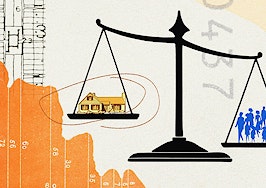- A new home affordability report shows 24 percent of markets are less affordable than their historical averages, up from 22 percent last quarter and 19 percent one year ago.
- Wage growth changed its course, from 13 consecutive quarterly rises to a 0.1 percent drop this time around.
- Some of the least affordable markets compared to their historical averages include New York City, Houston and San Francisco.
Unfortunately for first-time buyers, housing affordability is worsening across many major real estate markets, according to a new report.
Attom Data Solutions’ Home Affordability Index shows that 24 percent of markets are less affordable than their historical averages, up from 22 percent in the second quarter of 2016 and 19 percent one year ago. The third quarter report reveals the largest number of markets reaching historical unaffordable levels since 2009, when 47 percent of markets became less reasonable than their long-term averages.

Although mortgage rates are down 45 basis points from one year ago, most markets displayed deteriorating housing affordability. Daren Blomquist, senior vice president of Attom Data Solutions, says improving affordability reported in the second quarter turned back.
“There was some evidence, that in our last quarterly report, that wage growth was starting to catch up with home price growth in an increasing number of markets,” Blomquist said. “But that reversed course in the latest data, where the majority of markets saw home price growth accelerate and wage growth decelerate, which resulted in worsening affordability in 63 percent of markets compared to a year ago.”
The national average weekly wage dipped in the third quarter after 13 uninterrupted quarters of annual growth, the report shows. To add fuel to the fire, home prices rose faster in 59 percent of markets compared to a year ago.
Even closing costs are up, according to data provided by ClosingCorp, which says the average closing costs for all 414 counties analyzed reached $3,815 — or 1.8 percent of the median sales price. Closing costs — including title, settlement services, appraisal, transfer taxes, recording fees and home inspections — represent 8 percent of average annual wages, the data shows.
Markets with historically worse housing affordability
Some of the most unaffordable markets relative to their historical data are located in New York City, Houston and the Bay Area. Median prices across these 101 counties are less affordable now compared to the first quarter of 2005.
Harris County (Houston), Kings County (Brooklyn), Bexar County (San Antonio) and Alameda County in the San Francisco Bay Area are now more unaffordable than their historical norms.
On the other hand, counties more affordable now compared to individual historical averages include Los Angeles County, Cook County (Chicago), Miami-Dade County and Queens County in New York City.
The silver lining on housing affordability
Thirty-seven percent of counties (153) saw affordability improve in this quarter, including Brooklyn — despite the fact that Kings County is still below its historical average.
Marin County north of San Francisco proper saw a 1 percentage point improvement in affordability, while nearby Santa Clara County posted a 3 percentage point improvement. Kings County and Arlington County in the Washington D.C. metro area saw the same 5 percentage point lift.
“What we see happening is some of these high-priced markets, like Brooklyn and Marin County, is that they are finally hitting that affordability ceiling and are starting to see home prices slow down, which is actually improving affordability,” Blomquist explained.
“Whereas the markets that still have some runway in terms of affordability are still continuing to see strong home price appreciation and worsening affordability.”
The other 63 percent of U.S. counties showed declining affordability levels. Although Los Angeles County is more affordable than its historical average, affordability worsened compared to 2015. As of the third quarter, affordability in Los Angeles is down 2 percentage points year-over-year.
Harris County saw affordability worsen by 3 percentage points year-over-year, while Miami-Dade County dipped 5 percentage points. Queens County, also more affordable now than its historical average, suffered a 1 percentage point fall in affordability.
Wage climb dips after consistent growth
According to Attom, average weekly wages are down 0.1 percentage points annually, while median home prices are up 7 percentage points in the same time. Since the market bottom in the first quarter of 2012, home prices grew 60 percentage points compared to a negligible 6 percentage point climb in wages.
The overwhelming majority of counties studied (89 percent) saw home price appreciation outpace wage growth. In the second quarter of this year, the share of counties with higher home price growth compared to income growth was just 58 percent.

Los Angeles, Chicago, Houston and San Diego were a few major metros most harshly affected by this worsening disparity. However, San Antonio (Comal County) and Washington D.C. (Stafford County) showcased accelerated wage growth compared to home price appreciation.
“Wages are the main culprit, but you still have generally strong home price growth in many markets causing this affordability conundrum,” Blomquist said.
On average, U.S. homebuyers must shell out 36.3 percent of their income to buy a median priced home, according to the report. While this is under the historical average of 38.8 percent, income-to-housing cost ratio is up from 35.9 percent last quarter and 35.8 percent from a year ago.
At the highest level, Brooklyn requires buyers to spend an average 123.5 percent of wages on a median priced home, while Manhattan home purchases require 96.6 percent of average wages, the report says.
In Santa Cruz County, the average earner spends 111.1 percent of income for a median priced home, while Marin County requires 109.4 percent of the average income.













